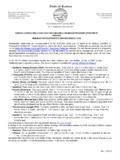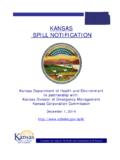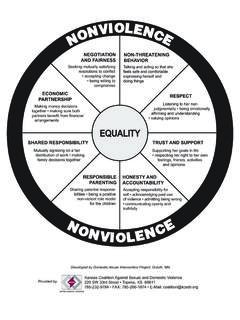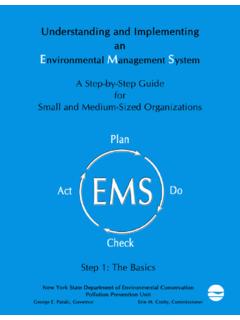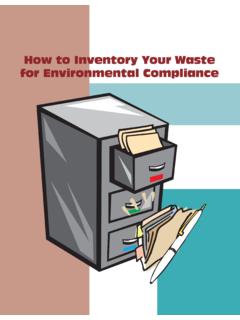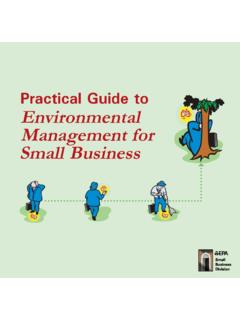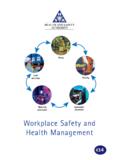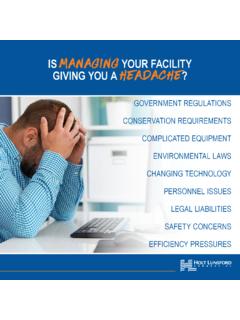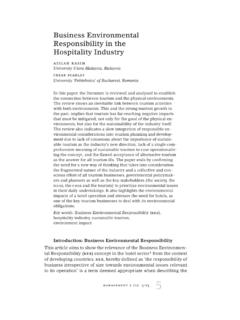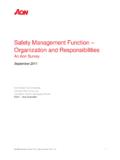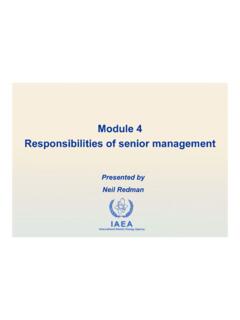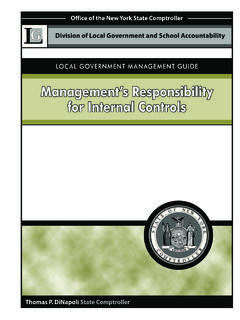Transcription of Environmental Management Systems - KDHE
1 Environmental Management Systemsprepared for the Small Business Leadership Training Program, 1998written by Jean S. Waters, Pollution Prevention Instituteproduced under the Small Business Leadership Training Grantprovided by the US EPA toKansas Department of Health and Environmentand under contract to the University of KansasCenter for Continuing 2 Standards 2 ISO 2 ISO 3 Sustainable 3 Environmental Stewardship Codes .. 4 Other EMS Standards .. 4 Trade and Marketing .. 4 Bottom Line .. 4 Improved Environmental Performance .. 5 Health and Safety .. 5 Employee participation .. 5 Key Concepts .. 6 Continual Improvement .. 6 Organizational priority .. 6 General requirements .. 6 Environmental 6 Planning .. 7 Environmental Aspects and Impacts .. 7 Legal and other requirements .. 8 Objectives and targets .. 9 Environmental Management Program .. 9 Implementation and 10 Structure and 10 Training .. 10 Communication .. 10 Documentation .. 11 Operational Control.
2 12 Emergency preparedness and 12 Checking and Corrective Action .. 12 Monitoring and Measurement .. 12 Nonconformance and corrective and preventative action .. 13 Records .. 14 EMS Audit .. 14 Management Review .. 16 Kansas Audit Bill .. 16 References .. 16 Additional Resources .. 17 IntroductionEnvironmental Management Systems (EMS) can be designed to have various degrees of inclusion of allenvironmental aspects of an organization. In their simplest form, they may be nothing more than a systemof organizing and disseminating information surrounding regulatory permits. Such a system may morecorrectly be called an Environmental Management Information system and although it s critical to aplanning process that you have accurate information, an EMS goes beyond this task. A true EMS includesevaluating and managing all potential Environmental ramifications of an an EMS means looking at everything from the Environmental impacts associated with gettingyou raw materials to impacts associated with ultimate disposal of the product you produce and everythingin Management cannot be restricted to waste Management .
3 Companies have seen real gains inwaste reduction in recent years through the waste minimization techniques of the 1980s and more recentlythe pollution prevention techniques of the 1990s. Pollution prevention calls for you to look at the entireprocess, determine the source of contamination and what can be done to prevent it. Likewise, trueenvironmental Management must include all aspects of the organization, such as personnel training,purchasing, Management organization, communication, risk Management , and emergency standards have been established for EMS. The International Standards Organization (ISO) hasestablished a series of Environmental standards (ISO 14000) that prescribe the necessary elements for anEMS. The ISO standard is the focus of this chapter. In addition, the Kansas Department of Health andEnvironment ( kdhe ) has established criteria for EMS. This will be covered later in this in the United States have tried to get some regulatory relief by implementing an EMS thatmeets the ISO 14000 standard.
4 The ISO standard is broad in scope and emphasizes total environmentalresponsibility. The standards have been criticized by some, though, because they are not specific withregard to compliance with all applicable Environmental regulations for all portions of the business. Forinstance, it would be possible for a manufacturing plant to be certified under the ISO 14001 standardwithout including the facility s waste water treatment plant. Also, the EMS only has to be in place and beprogressing. Even if you are out of compliance in an area, you can still meet the ISO standard as long asyour system finds the problem and you progress toward the agencies are much more interested in assuring compliance. While they may appreciate yourefforts toward improvement, they want to assure that you remain in compliance at all times. Therefore,they have established their own criteria for Environmental Management Systems and have afforded somebenefits for companies that have an EMS in place and find a violation during a self-audit.
5 Businesses alsoresist EMS legislation, believing the government should regulate performance and not mandate how it ISO 14000 standard follows this philosophy. Although the steps to having an EMS are well defined,implementation and the exact form of each step is left up to the individual BackgroundISO 14000 ISO is the International Organization for Standardization. It was established in Geneva, Switzerland in1946 to promote international trade by harmonizing standards. ISO has developed international voluntaryconsensus standards for manufacturing, communication, trade, and Management Systems . The UnitedStates is represented by the American National Standards Institute (ANSI).The need for international Environmental Management standards was assessed by the Strategic AdvisoryGroup on the Environment (SAGE), a committee established by ISO in 1991. They recommendeddevelopment of a standard and in January 1993, ISO created Technical committee 207 (TC 207) to developthe ISO 14000 series of 20 standards.
6 TC 207 is composed of various subcommittees and working groups. Representatives from the ISO member countries contribute their input to TC 207 through Technical Advisory Group ( TAG) develops the position on various ISO 14000standards. TAG is comprised of approximately 500 members representing industry, government, not-for-profit organizations, standards organizations, Environmental groups, and other interested stakeholders. Several organizations are involved in the administration of TAG s input to TC 207, including: ANSI,the American Society for Testing and Materials (ASTM), and the American Society for quality Control(ASQC).TC 207 is developing the ISO 14001 Standard which specifies requirements for an environmentalmanagement system . An organization can actually become registered to the ISO 14001 Standard for theirEMS. Several guidance documents are also being developed and Environmental auditing guidelines havebeen published. Published ISO standards must be reviewed every five standards are designed to help manufacturing and service companies of any size, or in any industrialsector, develop a uniform set of Environmental Management elements that will help to achieve their ownenvironmental goals.
7 If you adopt the standard, you make a clear Management commitment to anenvironmental policy, form a plan to carry out the policy, identify activities that significantly impact theenvironment, and train employees in Environmental practices. You also create a review system to assureprograms are implemented and maintained. In a nutshell, an effective EMS of clear goals, supported by Management , with respect to the and implementation of ways to measure and progress toward the and episodic review and 9000In 1987, the ISO 9000 series of quality Management standards was published. The standards promoteconsistent quality practices and facilitate international trade. The standards are used as a benchmark forquality Management by industry and government worldwide with over 81 countries adopting the standardsand over 13,000 companies in North America attaining registration. The ISO 14000 standards follow the same continuous improvement principles of Management as the ISO9000 standards.
8 The quality standards apply to consistency of the production processes while theenvironmental standards apply to the company s Environmental aspects and DevelopmentThe term sustainable development was coined in 1987 by the World Commission on Environment andDevelopment, in it s report, Our Common Future. This report emphasized the need to balanceenvironmental protection and economic International Chamber of Commerce (ICC) created the Business Charter for Sustainable Developmentin 1991. The ICC Charter is comprised of sixteen Principles for Environmental Management that fostersustainable development. The Principles in this document include some of the basic elements ofenvironmental Management United Nations Conference on Environment and Development (UNCED) was held in Rio de Janeiroin 1992, and is also called the Earth Summit (or Rio Summit). Two documents from this summit areAgenda 21 and the Rio Declaration. Agenda 21 is a comprehensive guidance document for sustainabledevelopment, and the Rio declaration is a set of 27 principles for achieving sustainable international initiatives on sustainable development signified new levels of environmentalresponsibilities for the business community worldwide.
9 Rather than simply complying with environmentalregulations, businesses were now being asked to consider their total impact on the environment and takesteps to mitigate that Stewardship CodesMany private sector programs have been established to encourage Environmental stewardship. TheChemical Manufacturers Association developed the Responsible Care program, the Global EnvironmentalManagement Initiative (GEMI) and the Coalition for Environmentally Responsible Economies (CERES)established Environmental principles (formerly the Valdez Principles).Other EMS StandardsThe British Standards Institute published BS7750 in 1992. This was the first national standard forenvironmental Management Systems . The British Standards Institute had previously published BS 5750, anational quality Management system standard, which was a significant contribution to the development ofISO 9000. ISO 14001 was largely based on BS 7750, however it is not as stringent as BS 7750.
10 Severalother countries, including Ireland, France, South Africa, and Spain also developed national environmentalstandards. The standards were all similar but significant differences and contradictory requirementsremained. Thus the need for an international standard was and MarketingThe international community appears to be adopting ISO 14000 as the Environmental Management Systemstandard. It is likely that certification will be a contract requirement for some government agencies andlarge contractors. The automotive, electronics, and chemical industries are all moving toward ISO or not your company is required to have a certified EMS, there may be marketing advantages topublicizing your EMS. If you can effectively communicate to your customer that you re environmentallyresponsible, it may provide you an edge in the marketplace. Your customer knows that if you have anEMS, you re concerned about the environment (where they and their children live), you will be less of apotential liability threat to them, and you re less likley to be shut down for Environmental reasons.


